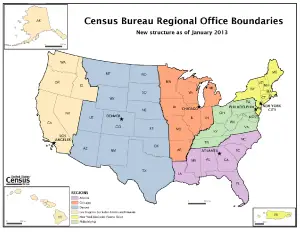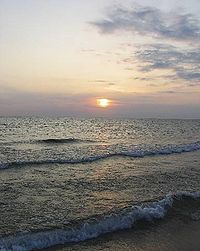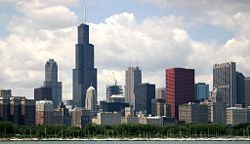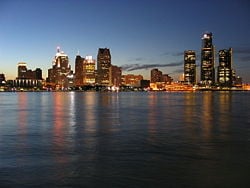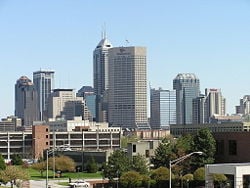Midwestern United States
((Images OK}}
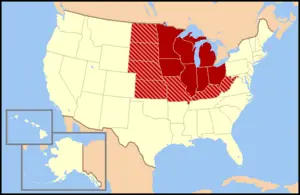
The Midwestern United States (or Midwest) refers to the north-central states of the United States of America, specifically Illinois, Indiana, Iowa, Kansas, Michigan, Minnesota, Missouri, Ohio, Nebraska, North Dakota, South Dakota and Wisconsin. A 2006 Census Bureau estimate put the population at 66,217,736. Both the geographic center and the population center of the contiguous United States are in the Midwest.
The Census Bureau divides this region into the East North Central states (essentially the Great Lakes states); and the West North Central states (essentially the Great Plains states), although Minnesota, which is listed among the West North Central states, is not listed as a Great Plains state.
Chicago is the largest city in the region, followed by Detroit and Indianapolis. Other important cities in the region include: Cincinnati, Cleveland, Columbus, Des Moines, Kansas City, Madison, Milwaukee, Minneapolis, Omaha, St. Louis, and Wichita.
The term Midwest has been in common use for over 100 years. Other designations for the region have fallen into disuse, such as the "Northwest" or "Old Northwest" (from Northwest Territory), "Mid-America," or "Heartland." Since the book Middletown appeared in 1929, sociologists have often used Midwestern cities, and the Midwest generally, as "typical" of the entire nation.[3] The Midwest region has a higher employment-to-population ratio (the percentage of employed people at least 16 years old) than the Northeast, the West, the South, or the Sun Belt states.[4]
Definition
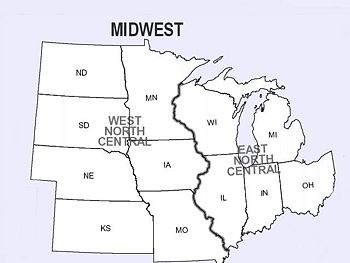
Traditional definitions of the Midwest include the Northwest Ordinance "Old Northwest" states and many states that were part of the Louisiana Purchase. The states of the Old Northwest are also known as "Great Lakes states." Many of the Louisiana Purchase states are also known as Great Plains states.
The North Central Region, is defined by the U.S. Census Bureau as these 12 states:
- Illinois: Old Northwest, Ohio River, and Great Lakes state.
- Indiana: Old Northwest, Ohio River, and Great Lakes state.
- Iowa: Louisiana Purchase, Great Plains state.
- Kansas: Louisiana Purchase, Border state, Great Plains state.
- Michigan: Old Northwest and Great Lakes state.
- Minnesota: Old Northwest and Great Lakes state; western part Louisiana Purchase.
- Missouri: Louisiana Purchase, Border state, Great Plains state.
- Nebraska: Louisiana Purchase, Great Plains state.
- North Dakota: Louisiana Purchase, Great Plains state .
- Ohio: Old Northwest (Historic Connecticut Western Reserve), Ohio River, and Great Lakes state. Also a Northeastern Appalachian state in the southeast.
- South Dakota: Louisiana Purchase, Great Plains state.
- Wisconsin: Old Northwest and Great Lakes state.
Physical geography
These states are generally perceived as being relatively flat. That is true of several areas, but there is a measure of geographical variation. In particular, the eastern Midwest lying near the foothills of the Appalachians, the Great Lakes Basin, and northern parts of Wisconsin, Minnesota, and Iowa demonstrate a high degree of topographical variety. Prairies cover most of the states west of the Mississippi River with the exception of eastern Minnesota, the Ozark Mountains of southern Missouri, and the southern tip of Illinois. Illinois lies within an area called the "prairie peninsula," an eastward extension of prairies that borders deciduousforests to the north, east, and south. Rainfall decreases from east to west, resulting in different types of prairies, with the tallgrass prairie in the wetter eastern region, mixed-grass prairie in the central Great Plains, and shortgrass prairie towardsthe rain shadow of the Rockies. Today, these three prairie types largely correspond to the corn/soybean area, the wheat belt, and the western rangelands, respectively. Hardwood forests in this area were logged to extinction in the late 1800s. The majority of the Midwest can now be categorized as urbanized areas or pastoral agricultural areas. Areas in northern Minnesota, Michigan, and Wisconsin, such as the Porcupine Mountains, and the Ohio River valley, are largely undeveloped.
Residents of the wheat belt, which consists of the westernmost states of the Midwest, generally consider themselves part of the Midwest, while residents of the remaining rangeland areas usually do not. Of course, exact boundaries are nebulous and shifting.
Ten largest Cities Midwestern U.S.
|
|
History
Exploration and early settlement
European settlement of the area began in the seventeenth century following French exploration of the region. The French established a network of fur trading posts and Jesuit missions along the Mississippi River system and the upper Great Lakes. French control over the area ended in 1763 with the conclusion of the French and Indian War. British colonists began to expand into the Ohio Country during the 1750s. The Royal Proclamation of 1763 temporarily restrained expansion west of the Appalachian Mountains, but did not stop it completely.
Early settlement began either via routes over the Appalachian Mountains, such as Braddock Road; or through the waterways of the Great Lakes. Fort Pitt, now Pittsburgh, at the source of the Ohio River, was an early outpost of the overland routes. The first settlements in the Midwest via the waterways of the Great Lakes were centered around military forts and trading posts such as Green Bay, Sault Ste. Marie, and Detroit. The first inland settlements via the overland routes were in southern Ohio or northern Kentucky, on either side of the Ohio River, and early such pioneers were Daniel Boone and Spencer Records.
Following the American Revolution, the rate of settlers coming from the eastern states increased rapidly. In the 1790s, American Revolutionary War veterans and settlers from the original states moved there in response to Federal government of the United States land grants. The Ulster-Scots Presbyterians of Pennsylvania (often through Virginia) and the Dutch Reformed, Quaker, and Congregationalists of Connecticut were among the earliest pioneers to Ohio and the Midwest.
The region's fertile soil made it possible for farmers to produce abundant harvests of cereal crops such as corn, oats, and, most important, wheat. In the early days, the region was soon known as the nation's "breadbasket."
Development of transportation
Two waterways have been important to the Midwest's development. The first and foremost was the Ohio River which flowed into the Mississippi River. Spanish control of the southern part of the Mississippi, and refusal to allow the shipment of American crops down the river and into the Atlantic Ocean, halted the development of the region until 1795.
The river inspired two classic American books written by a native Missourian, Samuel Clemens, who took the pseudonym Mark Twain: Life on the Mississippi and Adventures of Huckleberry Finn. Today, Twain's stories have become staples of Midwestern lore. Twain's hometown of Hannibal, Missouri is a tourist attraction in the area offering a glimpse into the Midwest of his time.
The second waterway is the network of routes within the Great Lakes. The opening of the [Erie Canal]] in 1825 completed an all-water shipping route, more direct than the Mississippi, to New York and the seaport of New York City. Lakeport cities grew up to handle this new shipping route. During the Industrial Revolution, the lakes became a conduit for iron ore from the Mesabi Range of Minnesota to steel mills in the Mid-Atlantic States. The Saint Lawrence Seaway later opened the Midwest to the Atlantic Ocean.
Inland canals in Ohio and Indiana constituted another great waterway, which connected into the Great Lakes and Ohio River traffic. The canals in Ohio and Indiana opened so much of Midwestern agriculture that it launched the world's greatest population and economic boom foreshadowing later "emerging markets." The commodities that the Midwest funneled into the Erie Canal down the Ohio River contributed to the wealth of New York City, which overtook Boston and Philadelphia. New York State would proudly boast of the Midwest as its "inland empire"; thus, New York would become known as the Empire State.
19th century sectional conflict
Because the Northwest Ordinance region, comprising the heart of the Midwest, was the first large region of the United States which prohibited slavery (the Northeastern United States emancipated slaves in the 1830s), the region remains culturally apart from the country and proud of its free pioneer heritage. The regional southern boundary was the Ohio River, the border of freedom and slavery in American history and literature (See: Uncle Tom's Cabin, by Harriet Beecher Stowe; Beloved, by Toni Morrison). The Midwest, particularly Ohio, provided the primary routes for the "Underground Railroad," whereby Midwesterners assisted slaves to freedom from their crossing of the Ohio River through their departure on Lake Erie to Canada.
The region was shaped by the relative absence of slavery (except for Missouri), pioneer settlement, education in one-room free public schools, and democratic notions brought with American Revolutionary War veterans, Protestant faiths and experimentation, and agricultural wealth transported on the Ohio River riverboats, flatboats, canal boats, and railroads.
Industrialization and immigration
By the time of the American Civil War, European immigrants bypassed the East Coast of the United States to settle directly in the interior: German immigrants Lutherans and Jews to Ohio, Wisconsin, Illinois, and eastern Missouri; Swedes and Norwegians to Wisconsin, Minnesota and northern Iowa. Poles, Hungarians, and German Catholics and Jews founded or settled in Midwestern cities. Many German Catholics also settled throughout the Ohio River valley and around the Great Lakes.
The Midwest was predominantly rural at the time of the Civil War, dotted with small farms across Ohio, Indiana and Illinois, but industrialization, immigration, and urbanization fed the Industrial Revolution, and the heart of industrial progress became the Great Lakes states of the Midwest. German, Scandinavian, Slavic and African-American immigration into the Midwest continued to bolster the population there in the nineteenth and twentieth centuries, though generally the Midwest remains a predominantly diverse, Protestant region. Large concentrations of Catholics are found in larger metropolitan areas because of German, Irish, Italian, and Polish immigration before 1915, and Mexican-American migration since the 1950s. Famous Amish farm settlements are found in northern Ohio, northern Indiana, and central Illinois.
In the twentieth century, African American migration from the Southern United States into the Midwestern states changed Chicago, St. Louis, Gary, Detroit, and many other cities dramatically, as factories and schools enticed families by the thousands to new opportunities.
History of the term "Midwest"
The term "Middle West" originated in the nineteenth century, followed by "Midwest." The heart of the Midwest is bounded by the Great Lakes and the Ohio and Mississippi River valleys, the "Old Northwest" (or the "West"), an area that comprised the original Northwest Territory. This area is now called the "East North Central States" by the United States Census Bureau and the "Great Lakes" region by its inhabitants.
The Northwest Territory was created out of the ceded English (formerly French and Native American) frontier lands under the Northwest Ordinance by the Continental Congress just before the U.S. Constitution was ratified. The Northwest Ordinance prohibited slavery and religious discrimination, and promoted public schools and private property, but did not apply after the territories became states. The Northwest Ordinance also specified that the land be surveyed and sold in the rectangular grids of the Public Land Survey System, which was first used in Ohio. The effect of this grid system can be seen throughout the Midwest in such things as county shapes and road networks.
In contrast, land in Kentucky and Tennessee was surveyed and sold using metes and bounds. As Revolutionary War soldiers were awarded lands in Ohio and migrated there and to other Midwestern states with other pioneers, the area became the first thoroughly "American" region. Frederick Jackson Turner celebrated its frontier for shaping the national character of individualism and democracy.
The Midwest region today sometimes refers not only to states created from the Northest Ordinance, but also may include states between the Appalachian Mountains and the Rocky Mountains and north of the Ohio River.
The term West was applied to the region in the early years of the country. Later, the region west of the Appalachians was divided into the Far West (now just the West), and the Middle West. Some parts of the Midwest have also been referred to as Northwest for historical reasons (for instance, this explains the Minnesota-based Northwest Airlines as well as Northwestern University in Illinois), so the current Northwest region of the country is called the Pacific Northwest to make a clear distinction.
The boundaries of what is considered the Midwest today are somewhat ambiguous. People from across the region consider themselves to be from the Midwest for very different reasons and have varying definitions and perceptions of the Midwest, and use has changed historically, gradually growing westward to include states which formerly were thought of as being the "West." Because the Northwest Territory lay between the East Coast and the then-far-West, the states carved out of it were called the "Northwest" in 1789, and "Middle West" by 1898.
In the early nineteenth century, anything west of the Mississippi River was considered the West, and the Midwest was the region west of the Appalachians and east of the Mississippi. In time, some users began to include Minnesota, Iowa and Missouri, and with the settlement of the western prairie, a new term, "Great Plains States," was used for the row of states from North Dakota to Kansas. Later, these states annexed themselves unofficially to the Midwest. Today, the term "Far West" means the West Coast, and people as far west as the prairie sections of Colorado, Wyoming and Montana sometimes identify themselves with the term Midwest.[7]
Culture
Midwesterners are alternately viewed as open, friendly, and straightforward, or sometimes stereotyped as unsophisticated and stubborn. They are also stereotyped as lacking in culture, mainly due to the very small number of minorities living in many Midwestern states (excluding major cities). Rural Midwesterners, such as those in Kansas and Nebraska, are sometimes stereotyped as rednecks. Factors that probably affected the shaping of Midwest values include the religious heritage of the abolitionist, pro-education Congregationalists to the stalwart Calvinist heritage of the Midwestern Protestants, as well as the agricultural values inculcated by the hardy pioneers who settled the area. The Midwest remains a melting pot of Protestantism and Calvinism, mistrustful of authority and power.
Catholicism is the largest single religious denomination in the Midwest, varying between 19 and 29 percent of the state populations. Baptists compose 14% of the populations of Ohio, Indiana, and Michigan, up to 22% in Missouri and down to 5% in Minnesota. Lutherans peak at 22-24% in Wisconsin and Minnesota, reflecting the Scandinavian and German heritage of those states. Pentecostal and charismatic denominations have few adherents in the Midwest, ranging between 1 and 7% (although the Assembly of God began in lower Missouri). Judaism and Islam are each practiced by 1% or less of the population, with slightly higher concentrations in major urban areas, such as Chicago, Indianapolis, St. Louis, Minneapolis, Detroit and Cleveland. Those with no religious affiliation make up 13-16% of the Midwest's population.
The rural heritage of the land in the Midwest remains widely held, even if industrialization and suburbanization have overtaken the states in the original Northwest Territory. Given the rural, antebellum associations with the Midwest, further rural states like Kansas have become icons of Midwesternism, most directly with the 1939 film The Wizard of Oz.
Midwestern politics tends to be cautious, but the caution is sometimes peppered with protest, especially in minority communities or those associated with agrarian, labor or populist roots. This was especially true in the early 20th century when Milwaukee was a hub of the socialist movement in the United States, electing three socialist mayors and the only socialist congressional representative (Victor Berger) during that time. The metropolis-strewn Great Lakes region tends to be the most liberal area of the Midwest, and liberal presence diminishes gradually as you move south and west from that region into the less-populated rural areas. The Great Lakes region has spawned people such as the La Follette political family, labor leader and five-time Socialist Party of America presidential candidate Eugene Debs, and Communist Party leader Gus Hall. Minnesota in particular has produced liberal national politicians Walter Mondale, Eugene McCarthy, and Hubert Humphrey and well as protest musician Bob Dylan.
Because of African-American migration from the South, a large African American urban population lives in most of the region's major cities, although the concentration is not nearly as large as that of the Southern United States. The combination of industry and cultures, Jazz, Blues, and Rock and Roll, led to an outpouring of musical creativity in the 20th century in the Midwest, including new music like the Motown Sound and techno from Detroit and house music & the blues from Chicago. Rock and Roll music was first identified as a new genre by a Cleveland radio DJ, and the Rock and Roll Hall of Fame is now located in Cleveland. See also Music of the Midwest/Motown, Detroit, 70s Soul Music, Ohio Players, Kool and The Gang, and Dayton. Today the population of the Midwest is 65,971,974, or 22.2% of the total population of the United States.
Cultural overlap with neighboring regions
Differences in the definition of the Midwest mainly split between the Heartland and the Great Plains on one side, and the Great Lakes and the Rust Belt on the other. While some point to the small towns and agricultural communities in Kansas, Iowa, the Dakotas and Nebraska of the Great Plains as representative of traditional Midwestern lifestyles and values, others would assert that the declining Rust Belt cities of the Great Lakes, with their histories of 19th- and early-20th century immigration, manufacturing base, and strong Catholic influence, are more representative of the Midwestern experience. Under such a definition, cities as far east as Buffalo, New York and Pittsburgh, Pennsylvania may be considered Midwestern in nature.
Certain areas of the traditionally defined Midwest are often cited as not being representative of the 'Midwest,' while other areas traditionally outside of the Midwest are often claimed to be part of the Midwest. These claims often embody historical, cultural, economic or demographic arguments for inclusion or exclusion.
The prairie parts of Montana, Wyoming, and especially Colorado are sometimes considered part of the Midwest, especially to people in the Great Plains which are closer to the geographic middle of the country. However, such an inclusion would be considered incorrect to most people in the Great Lakes region as many people near the Great Lakes do not even consider the Plains states to be the Midwest, as much of those states are ranchland.
Political trends
One of the two major political parties in the United States, the Republican Party, originated partially in the Midwest. One of its founding places was Jackson, Michigan or Ripon, Wisconsin in the 1850s and included opposition to the spread of slavery into new states as one of its agendas. Most of the rural Midwest is considered to be a Republican stronghold to this day, and Hamilton County, the home of Cincinnati, Ohio, is one of the few metropolitan counties in America which voted predominantly Republican at the close of the 20th century. From the American Civil War to the Great Depression and World War II, Midwestern Republicans dominated American politics and industry, just as Southern Democrat farmers dominated antebellum rural America and as Northeastern financiers and academics in the Democratic party would dominate America from the Depression to the Vietnam War and the height of the Cold War.
As political trends have changed and the Midwest's population has shifted from the countryside to its cities, the general political mood has moved to the center, and the region is now home to many critical swing states that do not have strong allegiance to either party. Upper Midwestern states, such as Illinois, Minnesota, Wisconsin, and Michigan have proven reliably Democratic, while even Iowa has shifted towards the Democrats. Normally a Republican stronghold, Indiana became a key state in the 2006 mid-term elections, picking up 3 House Seats to bring the total to 5 Democrats to 4 Republicans representing Indiana in the U.S. House. The state government of Illinois is currently dominated by the Democratic Party. Both of Illinois's senators are Democrats and a majority of the state's U.S. representatives are also Democrats. Illinois voters have preferred the Democratic presidential candidate by a significant margin in the past four elections (1992, 1996, 2000, 2004). The same is true of Michigan and Wisconsin, which also currently have a Democratic governor and two Democratic senators. Iowa is considered by many analysts to be the most evenly divided state in the country, but has leaned Democratic for the past fifteen years or so. Iowa has a Democratic governor, a Democratic Senator, three Democratic Congressmen out of five, has voted for the Democratic presidential candidate in three out of the last four elections, (1992, 1996, 2000). As of the 2006 midterms elections, Iowa has a state legislature dominated by Democrats in both chambers. Minnesota voters have chosen the Democratic candidate for president longer than any other state. Minnesota was the only state among the 50 states (along with Washington, D.C.) of the U.S. to vote for Walter Mondale over Ronald Reagan in 1984 (Minnesota is Mondale's home state). In Iowa and Minnesota, however, the recent Democratic pluralities have often been fairly narrow. Minnesota has elected and reelected a Republican governor, as well as supported some of the most pro-gun concealed weapon laws in the nation.
In 2006, Democrats scored major gains across the region. In Iowa, Democrats gained control of the state legislature and held onto the governor's mansion, giving them one-party control of Iowa's government. Elsewhere, Democrats gained control of the Wisconsin Senate, the Michigan Legislature, and the Indiana General Assembly. Minnesota, thought to be trending Republican, saw the DFL post double-digit gains in the Minnesota House and win all state-wide elections, save for the gubernatorial race. Democrats also won all state-wide races in Ohio, and gained control of all Illinois statewide offices.
On a federal level, Democrat Sherrod Brown defeated incumbent Mike DeWine 56-44. Democrats also picked up other seats in Indiana, Iowa, Minnesota, Ohio, and Wisconsin.
By contrast, the Great Plains states of North Dakota, South Dakota, Nebraska, and Kansas have been strongholds for the Republicans for many decades. These four states have gone for the Republican candidate in every presidential election since 1940, except for Lyndon B. Johnson's landslide over Barry Goldwater in 1964. However, North Dakota's Congressional delegation has been all-Democratic since 1987, and South Dakota has had at least two Democratic members of Congress in every year since 1987. Nebraska has elected Democrats to the Senate and as Governor in recent years, but the state's House delegation has been all-Republican since 1995. Kansas has elected a majority of Democrats as governor since 1956 and currently has a 2-2 split in its House delegation, but has not elected a Democrat to the Senate since 1932.
Missouri is considered a "bellwether state." Only once since 1904 has the Show-Me-State not voted for the winner in the presidential election, in 1956. Missouri's House delegation has generally been evenly divided between Democrats and Republicans, with the Democrats holding sway in the large cities at the opposite ends of the state, Kansas City and St. Louis, and the Republicans controlling the rest of the state. Missouri's Senate seats were mostly controlled by Democrats until the latter part of the 20th century, but the Republicans have held one or both Senate seats continuously since the 1976 elections.
Around the turn of the twenyieth century, the region also spawned the Populist Movement in the Plains states and later the Progressive Movement, which largely consisted of farmers and merchants intent on making government less corrupt and more receptive to the will of the people. The Republicans were unified anti-slavery politicians, whose later interests in invention, economic progress, women's rights and suffrage, freedman's rights, progressive taxation, wealth creation, election reforms, temperance and prohibition eventually clashed with the Taft-Roosevelt split in 1912. Similarly, the Populist and Progressive Parties grew out intellectually from the economic and social progress claimed by the early Republican party. The Protestant and Midwestern ideals of profit, thrift, work ethic, pioneer self-reliance, education, democratic rights, and religious tolerance influenced both parties despite their eventual drift into opposition.
The Midwest has long mistrusted Northeastern elitism. Some favor isolationism, a belief held by George Washington that Americans should not concern itself with foreign wars and problems. It gained much support from German American and Swedish American communities, and leaders like Robert La Follette, Robert A. Taft, and Colonel Robert McCormick, publisher of the Chicago Tribune.[8]
Unemployment remains low (under 5%), but is higher than the national average; some manufacturing-dependent states—most notably Michigan—have still higher unemployment rates.[9] Outsourcing of higher paying manufacturing jobs and a rise in low-wage service jobs is a major issue.
Linguistic characteristics
The accents of the region are generally distinct from those of the South and many urban areas of the American Northeast. The accent of most of the Midwest is considered by many to be "standard" American English.
However, many Midwestern cities are now undergoing the Northern Cities Shift away from the standard accent.
In some regions, particularly the farther north into the Upper Midwest one goes, a definite accent is detectable, usually reflecting the heritage of the area. For example, Minnesota, western Wisconsin, and Michigan's Upper Peninsula have strong Scandinavian accents, which intensifies the farther north one goes. Michigan accents closely resemble Canadian ones across the border. Many parts of western Michigan have a noticeable Dutch-flavored accent.
Also, residents of Chicago are recognized to have their own distinctive nasal accent (the Chicago bark), with a similar accent occurring in parts of Wisconsin, Michigan, Northern Indiana, Cleveland, and Western New York State. Arguably, this may have been derived from heavy Irish, German, Polish, and Eastern European influences in the Great Lakes Region. The most southern parts of the Midwest, generally south of U.S. Route 50, show distinctly southern speech patterns.
Notes
- ↑ (1955) The North American Midwest: A Regional Geography. New York, New York: Wiley Publishers. ISBN 0901411931.
- ↑ [1]
- ↑ Sisson (2006) pp 69-73; Richard Jensen, "The Lynds Revisited," Indiana Magazine of History (Dec 1979) 75: 303-319, online at [2]
- ↑ Bureau of Labor Statistics
- ↑ Incorporated Places of 100,000 or More Ranked by Population: 2000 (pdf) U.S. Census Bureau. April 22001. Accessed November 202007.
- ↑ Population in Metropolitan and Micropolitan Statistical Areas Ranked by 2000 Population for the United States and Puerto Rico: 1990 and 2000 (pdf). U.S. Census Bureau. December 302003. Accessed November 202007.
- ↑ Sisson (2006) pp 57-60
- ↑ Ralph H. Smuckler, "The Region of Isolationism," American Political Science Review, Vol. 47, No. 2 (Jun., 1953), pp. 386-401 in JSTOR; John N. Schacht, Three Faces of Midwestern Isolationism: Gerald P. Nye, Robert E. Wood, John L. Lewis (1981).
- ↑ Unemployment in the region was 4.8% in November 2006, compared to 4.5% nationally.[3]
ReferencesISBN links support NWE through referral fees
- Buley, R. Carlyle. The Old Northwest: Pioneer Period 1815-1840 2 vol (1951), Pulitzer Prize
- Cayton, Andrew R. L. Midwest and the Nation (1990)
- Cayton, Andrew R. L. and Susan E. Gray, Eds. The American Midwest: Essays on Regional History. (2001)
- Frederick; John T. ed. Out of the Midwest: A Collection of Present-Day Writing (1944) literary excerpts
- Garland, John H. The North American Midwest: A Regional Geography (1955)
- Jensen, Richard. The Winning of the Midwest: Social and Political Conflict, 1888-1896 (1971)
- Fred A. Shannon, "The Status of the Midwestern Farmer in 1900." The Mississippi Valley Historical Review. Vol. 37, No. 3. (Dec., 1950), pp. 491-510. in JSTOR
- Richard Sisson, Christian Zacher, and Andrew Cayton, eds. The American Midwest: An Interpretive Encyclopedia (Indiana University Press, 2006), 1916 pp of articles by scholars on all topics covering the 12 states; ISBN 0-253-34886-2 ISBN-13: 978-0-253-34886-9
- Terre Haute Tribune-Star (West Central news daily)
- Meyer, David R. "Midwestern Industrialization and the American Manufacturing Belt in the Nineteenth Century." Vol. 49, No. 4 (Dec., 1989) pp. 921-937. The Journal of Economic History, [4], JSTOR.
Central • Coastal States • Deep South • Upland South • East • East Coast • Great Basin • Gulf Coast • Mid-Atlantic • Midwest • Mountain States • New England • North • Northeast • Northwest • Pacific • South • South Atlantic • South Central • Southeast • Southwest • Upper Midwest • West • West Coast
Multinational regions: Atlantic Northeast • Border States • Great Lakes • Great Plains • Pacific Northwest
Credits
New World Encyclopedia writers and editors rewrote and completed the Wikipedia article in accordance with New World Encyclopedia standards. This article abides by terms of the Creative Commons CC-by-sa 3.0 License (CC-by-sa), which may be used and disseminated with proper attribution. Credit is due under the terms of this license that can reference both the New World Encyclopedia contributors and the selfless volunteer contributors of the Wikimedia Foundation. To cite this article click here for a list of acceptable citing formats.The history of earlier contributions by wikipedians is accessible to researchers here:
The history of this article since it was imported to New World Encyclopedia:
Note: Some restrictions may apply to use of individual images which are separately licensed.
